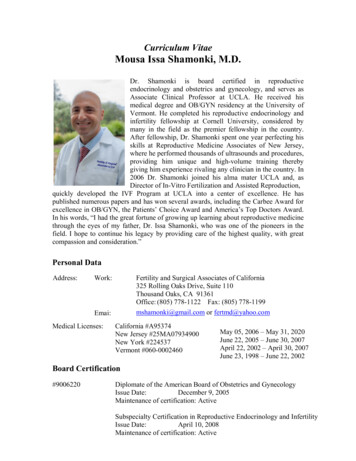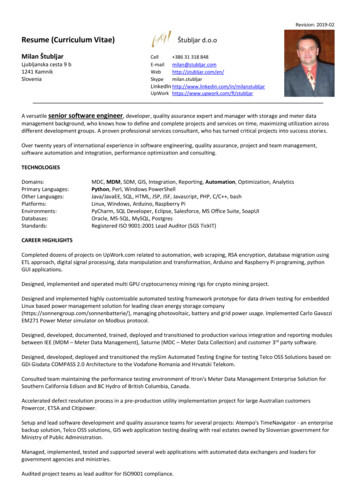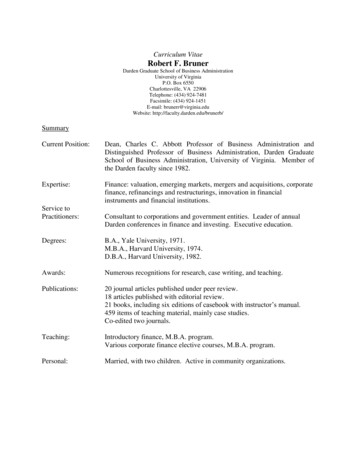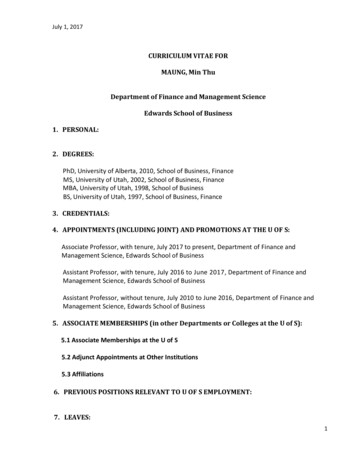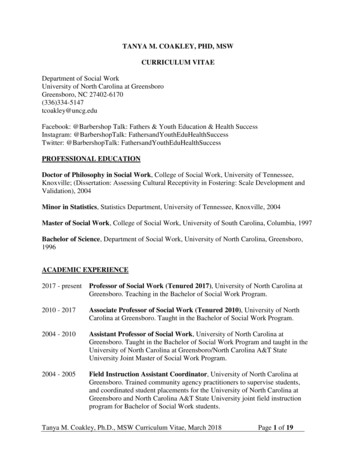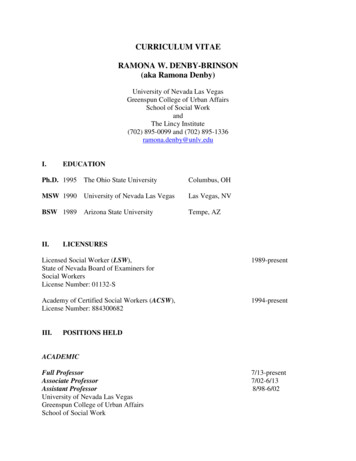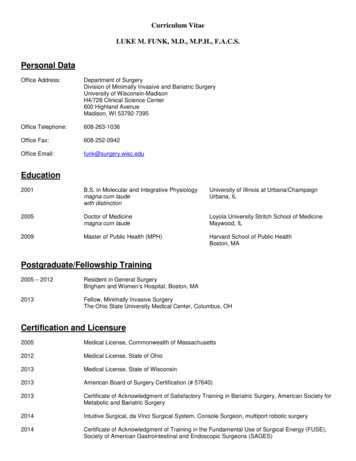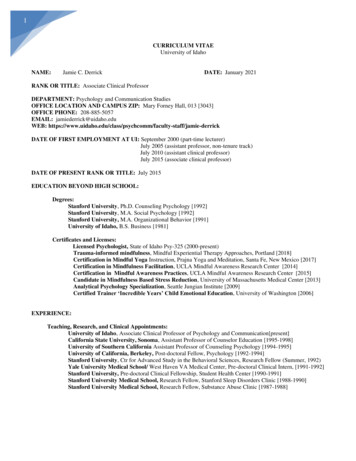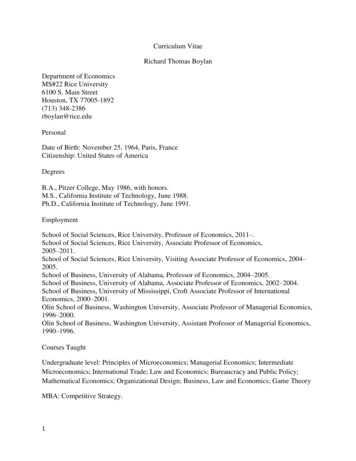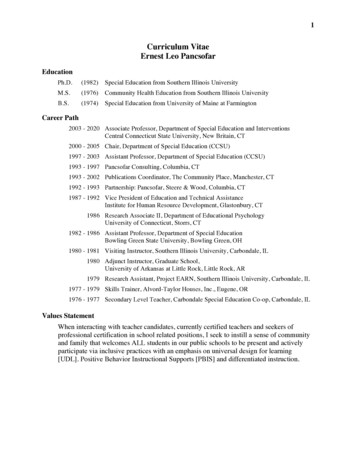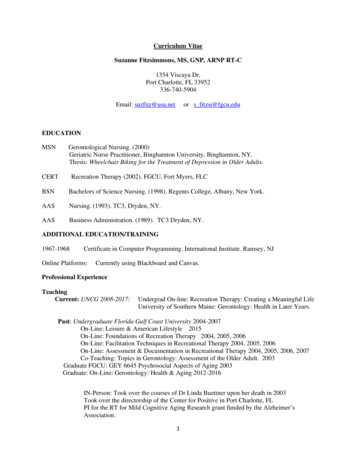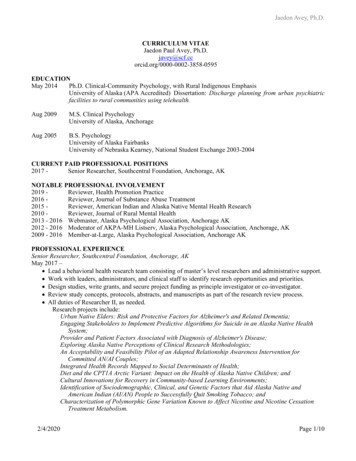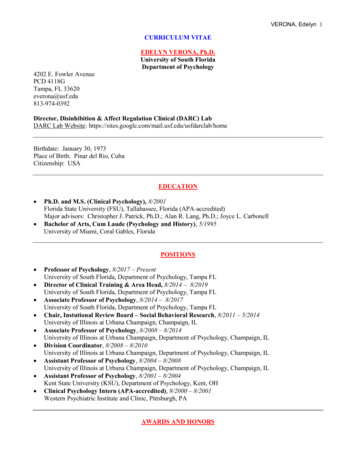
Transcription
VERONA, Edelyn 1CURRICULUM VITAE4202 E. Fowler AvenuePCD 4118GTampa, FL 33620everona@usf.edu813-974-0392EDELYN VERONA, Ph.D.University of South FloridaDepartment of PsychologyDirector, Disinhibition & Affect Regulation Clinical (DARC) LabDARC Lab Website: omeBirthdate: January 30, 1973Place of Birth: Pinar del Rio, CubaCitizenship: USAEDUCATION Ph.D. and M.S. (Clinical Psychology), 8/2001Florida State University (FSU), Tallahassee, Florida (APA-accredited)Major advisors: Christopher J. Patrick, Ph.D.; Alan R. Lang, Ph.D.; Joyce L. CarbonellBachelor of Arts, Cum Laude (Psychology and History), 5/1995University of Miami, Coral Gables, FloridaPOSITIONS Professor of Psychology, 8/2017 – PresentUniversity of South Florida, Department of Psychology, Tampa FLDirector of Clinical Training & Area Head, 8/2014 – 8/2019University of South Florida, Department of Psychology, Tampa FLAssociate Professor of Psychology, 8/2014 – 8/2017University of South Florida, Department of Psychology, Tampa FLChair, Instutional Review Board – Social Behavioral Research, 8/2011 – 5/2014University of Illinois at Urbana Champaign, Champaign, ILAssociate Professor of Psychology, 8/2008 – 8/2014University of Illinois at Urbana Champaign, Department of Psychology, Champaign, ILDivision Coordinator, 8/2008 – 8/2010University of Illinois at Urbana Champaign, Department of Psychology, Champaign, ILAssistant Professor of Psychology, 8/2004 – 8/2008University of Illinois at Urbana Champaign, Department of Psychology, Champaign, ILAssistant Professor of Psychology, 8/2001 – 8/2004Kent State University (KSU), Department of Psychology, Kent, OHClinical Psychology Intern (APA-accredited), 9/2000 – 8/2001Western Psychiatric Institute and Clinic, Pittsburgh, PAAWARDS AND HONORS
VERONA, Edelyn 2List of Teachers Ranked as Excellent by their Students, University of Illinois, Spring 2013Mid-Career Research Award, Social and Behavioral Research Council, University of Illinois, April 2013Distinguished Early Career Contributions to the Scientific Study of Psychopathy, Society for theScientific Study of Psychopathy, March 2011Fellow, Association for Psychological Science (APS), 2011Invited Scholar, Lorentz Center Conference on “Context, Causes, and Consequences of Conflict”,University of Leiden, The Netherlands, August 2009Top Reviewer, Biological Psychology, 2009Arnold O. Beckman Award, University of Illinois, 2006 and 2010.Featured Early Career Research Psychologist, APA’s 2nd Annual Science Leadership Conference,December 2006Visiting Fellow, APA Advance Training Institute in fMRI, Massachussetts General Hospital, May 2006Clinical Research Loan Repayment Award, National Institutes of Health (NIH), 2004-2006 and 20062008Farris Family Innovation Fund for Early Achievement, Kent State University, 2002Mind and Emotion Conference Travel Award, University of Minnesota, 2001Dolores Auzenne Minority Graduate Fellowship, Florida State University, 2000-2001Kellogg Dissertation Research Award, Florida State University, 1999Office of Graduate Studies Dissertation Research Award, Florida State University, 1999Phi Beta Kappa and Phi Kappa Phi Honor Societies as a Junior, University of Miami, 1994Research interests: psychology and crime; psychosocial and biological processes involved inviolence/aggression, psychopathic traits, self-harm and substance use; intervention & prevention practices in thecriminal justice systemClinical interests: personality disorders, emotional dysregulation, impulsivity, behavioral therapy, DialecticalBehavior Therapy, pre- and post-release interventions to reduce recidivism, telehealthPUBLICATIONS* Denotes current or former graduate student advisee** Denotes current or former undergraduate/pre-graduate student adviseeJournal Articles1. *Edwards, B., Mills, J.L., Reynolds, B.L., Verona, E. , Kiehl, K.A. (in press). Psychopathy and substanceuse in relation to prostitution and pimping among women offenders. Personality Disorders: Theory,Research, & Treatment.2. Patrick, C.J., Joyner, K.J., Watts, A.L., Lilienfeld, S.O., Somma, A., Fossati, A., Donnellan, M.B.,Hopwood, C.J., Sellbom, M., Drislane, L.E., Edens, J.F., Verona, E., Latzman, R.D., Sica, C., Benning,S.D., Morey, L.C., Hicks, B.M., Fantis, K.A., Blonigen, D.M., Molto, J., Krueger, R. (in press). LatentVariable Modeling of Item-Based Factor Scales: Comment on Triarchic or Septarchic?—Uncovering theTriarchic Psychopathy Measure’s (TriPM) Structure, by Roy et al. Personality Disorders: Theory,Research, and Treatment.3. *McDonald, J., *Bozzay, M., *Bresin, K., & Verona, E. (in press). Facets of ExternalizingPsychopathology in Relation to Inhibitory Control and Error Processing. International Journal ofPsychophysiology.4. *Bresin, K., & Verona, E. (in press). Craving and Illicit Substance Use: Examining Psychophysiologicaland Behavioral Moderators. International Journal of Psychophysiology.5. *Hoffmann, A., & Verona, E. (in press). Psychopathic traits and sexual coercion against relationship
VERONA, Edelyn3partners in men and women. Journal of Interpersonal Violence.6. Fox, B., *Gill, L., *Kortright, K., *Oramas Mora, D., Moule, R., & Verona, E. (2021). Heterogeneity in theContinuity and Change of Early and Adult Risk Factor Profiles of Incarcerated Offenders: A LatentTransition Analysis. Youth Violence and Juvenile Justice, 19, 68-93.7. Fox, B., *Bozzay, M., & Verona, E. (2020). An Analysis of Monoamine-Related Genotypes and ChildhoodTrauma in Relation to Psychopathic Traits in Men and Women. Crime & Delinquency, 66, 1438-1469.8. *Bozzay, M.L., *Joy, L.N., & Verona, E. (2020). Family violence pathways and externalizing behavior inyouth. Journal of Interpersonal Violence, 35, 5726-5752.9. *Yoon, S., Verona, E. Schlauch, R., Schneider, S., & Rottenberg, J. (2020). Why Do Depressed PeopleChoose Sad Stimuli? Emotion, 20, 613-624.10. Alia-Klein, N., Gan, G., Gilam, G., Bezek, J., Bruno, A., Denson, T.F., Hendler, T., Lowe, L., Mariotti, V.,Muscatello, M.R., Palumbo, S., Pellegrini, S., Pietrini, P., Rizzo, A., Verona, E. (2020). The feeling ofanger: from brain networks to linguistic expressions. Neuroscience & Biobehavioral Reviews, 108, 480-497.11. Fox, B., Verona, E., & *Fournier, L. (2019). Psychological assessment of risk in a county jail: implicationsfor reentry, recidivism and detention practices in the USA. Journal of Criminal Psychology, 9, 173-186.12. *Walden, A. L., *Joseph, N., & Verona, E. (2019). Reaching Under-Served Youth: A Pilot Implementationof a Skills-Based Intervention in Short-Term Juvenile Detention. Journal of Prevention and Intervention inthe Community, 47, 90-103.13. *Hoffmann, A.M., & Verona., E. (2019). Psychopathic Traits, Gender, and Sexual Motivations: PutativePaths to Sexual Coercion. Aggressive Behavior, 45, 527–53614. *Bresin, K., **McCowan, K., & Verona, E. (2019). The Effect of Rumination on Recall of EmotionalWords: Comparison of Dysphoric Individuals With and without a History of Nonsuicidal Self-injury.Cognition & Emotion, 33, 1655-1671.15. *Kruepke, M., *Molloy, E.K., *Bresin, K., Barbey, A.K., & Verona, E. (2018). A Brief Assessment Toolfor Investigating Real-Life Moral Judgments. Behavior Research Methods, 50, 922-936.16. Verona, E., *Murphy, B., & *Bresin, K. (2018). Oxytocin-related single nucleotide polymorphisms, familyenvironment, and psychopathic traits. Personality Disorders: Theory, Research & Treatment, 9, 584-589.17. *Bresin, K., *Mekawi, Y., & Verona, E. (2018). The effect of laboratory manipulations of negative affecton alcohol craving and use: A meta-analysis. Psychology of Addictive Behaviors, 32, 617-627.18. *Bresin, K., **Kling, L., & Verona, E. (2018). The effect of acute physical pain on subsequent negativeemotional affect: A meta-analysis. Personality Disorders: Theory, Research, and Treatment, 9, 273-283.19. *McKinley, S., Patrick, C.J., & Verona, E. (2018). Antisocial Personality Disorder: Neurophysiologicalmechanisms and distinct subtypes. Current Behavioral Neuroscience Reports, 5, 72-80. (Invited paper)20. Verona, E. & *Bozzay, M.L. (2017). Biobehavioral approaches to aggression implicate perceived threatand insufficient sleep: Clinical relevance and policy implications. Policy Insights from the Behavioral andBrain Sciences, 4, 178-185. (Invited Paper)21. *Edwards, B., **Albertson, E., & Verona, E. (2017). Dark and vulnerable personality trait correlates ofdimensions of criminal behavior among adult offenders. Journal of Abnormal Psychology, 126, 921-927.22. *Bresin, K., & Verona, E. (2016). Pain, Affect, and Rumination: An Experimental Test of the EmotionalCascade Theory in Two Undergraduate Samples. Journal of Experimental Psychopathology, 7, 205-224.23. Verona, E. (2016). Cognition-Emotion Interactions and Psychopathic Personality: Distinct Pathways toAntisocial and Violent Behavior (article in French). Santé mentale au Québec, 41, 65-83. (Invited Paper)24. *Bozzay, M.L., Karver, M.S., & Verona, E. (2016). Linking insomnia and suicide ideation in collegefemales: The role of socio-cognitive variables and depressive symptoms in suicide risk. Journal of AffectiveDisorders, 199, 106-113.25. *Hefner, K.R., Verona, E., & Curtin, J. (2016). Emotion regulation during threat: Parsing the time courseand consequences of safety signal processing. Psychophysiology, 53, 1193-1202.26. *Edwards, B., & Verona, E. (2016). Gendered contexts: psychopathy and drug use in relation to sex workand exchange. Journal of Abnormal Psychology, 125, 514-527.27. **Schultz, N., *Murphy, B., & Verona, E. (2016). Gender differences in psychopathy links to drug use.Law & Human Behavior, 40, 159-168.28. Verona, E., *Murphy, B., & *Javdani, S. (2016). Gendered pathways: violent childhood maltreatment, sexexchange, and drug use. Psychology of Violence, 6, 124-134.
VERONA, Edelyn429. Verona, E., & *Bresin, K. (2015). Aggression proneness: transdiagnostic processes involving negativevalence and cognitive systems. International Journal of Psychophysiology, 98, 321-329. (Invited Paper)30. *Zhang, W., *Finy, M.S., *Bresin, K., & Verona, E. (2015). Specific Patterns of Family Aggression andAdolescents’ Self and Other-Directed Harm: The Moderating Role of Personality. Journal of FamilyViolence, 30, 161-170.31. *Finy, M. S., *Bresin, K., Korol, D. L., & Verona, E. (2014). Impulsivity, risk taking, and cortisolreactivity as a function of psychosocial stress and personality in adolescents. Development andPsychopathology, 26, 1093-1111.32. *Bresin, K., *Finy, M.S., *Sprague, J., & Verona, E. (2014). Response Monitoring and Adjustment:Differential Relations with Psychopathic Traits. Journal of Abnormal Psychology, 123, 634-639.33. **Mager, K.L., *Bresin, K., & Verona, E. (2014). Gender, Psychopathy Factors, and Intimate PartnerViolence. Personality Disorders: Theory, Research, and Treatment, 5, 257-267.34. *Javdani, S., *Finy, M.S. & Verona, E. (2014). Evaluation of the Validity of the MultidimensionalPersonality Questionnaire – Simplified-Wording Form (MPQ-SF) in Adolescents with TreatmentHistories. Assessment, 21, 352-362.35. *Dworkin, E., *Javdani, S., Verona, E., & Cambell, R. (2014). Child sexual abuse and disordered eating:The mediating role of impulsive and compulsive tendencies. Psychology of Violence, 4, 21-36.36. Verona, E., *Bresin, K., & Patrick, C. J. (2013). Revisiting psychopathy in women: Cleckley/Hareconceptions and affective response. Journal of Abnormal Psychology, 122, 1088-1093.37. *Bresin, K., *Finy, M. S., & Verona, E. (2013). Childhood emotional maltreatment and self-injuriousbehaviors: The moderating role of BDNF Val66Met polymorphism. Journal of AffectiveDisorders, 150, 594-600.38. Patrick, C.J., Kramer, M., Tellegen, A., Verona, E., & Kaemmer, B.A. (2013). Development andpreliminary validation of a Simplified-Wording Form of the Multidimensional Personality Questionnaire.Assessment, 20, 405-418.39. *Sadeh, N., *Javdani, S., & Verona, E. (2013). Analysis of monoaminergic genes, childhood abuse, anddimensions of psychopathy. Journal of Abnormal Psychology, 122, 167-179.40. Verona, E., *Sprague, J., & *Javdani, S. (2012). Gender and factor level interactions in psychopathy:Implications for suicide-related behavior and borderline personality disorder. Personality Disorders:Theory, Research, and Treatment, 3, 247-262.41. *Sadeh, N., & Verona, E. (2012). Visual Complexity Attenuates Emotional Processing in Psychopathy:Implications for Fear-Potentiated Startle Deficits. Cognitive, Affective, and Behavioral Neuroscience, 12,346-360.42. Verona, E., *Sprague, J., & *Sadeh, N. (2012). Inhibitory control and negative emotional processing inpsychopathy and antisocial personality disorder. Journal of Abnormal Psychology, 121, 498-510.43. *Sprague, J., *Javdani, S., *Sadeh, N., Newman, J., & Verona, E. (2012). Borderline Personality Disorderas a Female Phenotypic Expression of Psychopathy? Personality Disorders: Theory, Research, andTreatment, 3, 127-139.44. Sachs-Ericsson, N., Keel, P.K., Holland, L., Selby, E.A., Verona, E., Cougle, J., & Palmer, E. (2012).Parental disorders, childhood abuse, and binge eating in a large community sample. International Journal ofEating Disorders, 45, 316-325.45. *Javdani, S., *Sadeh, N., & Verona, E. (2011). Expanding our Lens: Female Pathways to AntisocialBehavior in Adolescence and Adulthood. Clinical Psychology Review, 31, 1324-48.46. Verona, E., & *Javdani, S. (2011). Dimensions of Adolescent Psychopathology and Relationships toSuicide Risk Indicators. Journal of Youth and Adolescence, 40, 958-971.47. *Javdani, S., *Sadeh, N., & Verona, E. (2011). Suicidality as a Function of Impulsivity,Callous/Unemotional Traits, and Depressive Symptoms in Youth. Journal of Abnormal Psychology, 120,400-413.48. Verona, E., *Javdani, S., & *Sprague, J. (2011). Comparing Factor Structures of AdolescentPsychopathology. Psychological Assessment, 23, 545-551.49. *Javdani, S., *Sadeh, N., & Verona, E. (2011). Gendered Social Forces: A Review of the Impact ofInstitutionalized Factors on Women and Girls’ Criminal Justice Trajectories. Psychology, Public Policy, &Law, 17, 161-211.
VERONA, Edelyn550. *Sprague, J., Verona, E., Kalkhoff, W., & *Kilmer, A. (2011). Moderators and Mediators in the StressAggression Relationship: The Role of Executive Function and State Anger. Emotion, 11, 61-73.51. *Schoenleber, M., *Sadeh, N., & Verona, E. (2011). Parallel syndromes: Two dimensions of narcissismand the facets of psychopathic personality. Personality Disorders: Theory, Research, and Treatment, 2, 113127.52. *Sadeh, N., *Javdani, S., *Finy, S.M., & Verona, E. (2011). Gender and Negative Emotional Links to Selfversus Other-Directed Violence. Journal of Consulting and Clinical Psychology, 79, 106-117.53. *Sadeh, N., *Javdani, S., *Jackson, J., Reynolds, E.K., Potenza, M.N., Gelernter, J., Lejuez, C.W., &Verona. E. (2010). Serotonin Transporter Gene Associations with Psychopathic Traits in Youth Vary as aFunction of Socioeconomic Resources. Journal of Abnormal Psychology, 119, 604-609.54. *Sprague, J., & Verona, E. (2010). Emotional Conditions Disrupt Behavioral Control among Individualswith Dysregulated Personality Traits. Journal of Abnormal Psychology, 119, 409-419.55. *Sadeh, N., Verona, E., *Javdani, S., & **Olson, L. (2009). Examining Psychopathic Tendencies inAdolescence from the Perspective of Personality Theory. Aggressive Behavior, 35, 399-407.56. Verona, E., *Sadeh, N., & Curtin, J.J. (2009). Stress-induced asymmetric frontal brain activity andaggression risk. Journal of Abnormal Psychology, 118, 131-145.57. Verona, E., *Sadeh, N., **Case, S., Reed, A., & **Bhattacharjee, A. (2008). Self-reported use of differentforms of aggression in adolescents and young adults: Validation and correlates. Assessment, 15, 493-510.58. *Sadeh, N., & Verona, E. (2008). Psychopathy traits and selective impairments in attentional functioning.Neuropsychology, 22, 669-680.59. Verona, E., & *Sullivan, E. (2008). Catharsis and aggression revisited: Heart rate reduction followingaggressive responding. Emotion, 8, 331-340.60. Verona, E., & *Kilmer, A. (2007). Stress exposure and affective modulation of aggressive behavior in menand women. Journal of Abnormal Psychology, 116, 410-421.61. *Sellbom, M., & Verona, E. (2007). Neuropsychological Correlates of Psychopathic Traits in a NonIncarcerated Sample. Journal of Research in Personality, 41, 276-294.62. Verona, E., Reed, A., Curtin, J., & *Pole, M. (2007). Gender differences in emotional and overt/covertaggressive responses to stress. Aggressive Behavior, 33, 261-271.63. Sachs-Ericsson, N., Verona, E., Joiner, T.E., & Preacher, K.J. (2006). Parental verbal abuse and themediating role of self-criticism in adult internalizing disorders. Journal of Affective Disorders, 93, 71-78.64. Verona, E., & Curtin, J.J. (2006). Gender differences in the negative affective priming of aggressivebehavior. Emotion, 6, 115-124.65. Verona, E., Joiner, T.E., Johnson, F., & Bender, T. (2006). Gender specific gene-environment interactionson laboratory-assessed aggression. Biological Psychology, 71, 33-41.66. Verona, E., & Sachs-Ericsson, N. (2005). The intergenerational transmission of externalizing behaviors inadult participants: The mediating role of childhood abuse. Journal of Consulting and Clinical Psychology,73, 1135-1145.67. Verona, E., Hicks, B., & Patrick, C.J. (2005). Psychopathy and suicidality in female offenders: Mediatingeffects of temperament and abuse. Journal of Consulting and Clinical Psychology, 73, 1065-1073.68. Verona, E. (2005). Moderating effects of rumination and gender on context-specific aggression. AggressiveBehavior, 31, 420-436.69. Verona, E., Patrick, C. J., & Curtin, J.J., Lang, P.J., & Bradley, M.M. (2004). Psychopathy andphysiological response to emotionally evocative sounds. Journal of Abnormal Psychology, 113, 99-108.70. Verona, E., Sachs-Ericsson, N., & Joiner, T.E. (2004). Suicide attempts associated with externalizingpsychopathology in an epidemiological sample. American Journal of Psychiatry, 161, 444-451.71. Verona, E., Patrick, C.J., & Lang, A.R. (2002). A direct assessment of the role of state and trait negativeemotion in aggressive behavior. Journal of Abnormal Psychology, 111, 249-258.72. Verona, E., Patrick, C.J., & Joiner, T.E. (2001). Psychopathy, antisocial personality, and suicide risk.Journal of Abnormal Psychology, 110, 462-470.73. Verona, E., & Carbonell, J.L. (2000). Female violence and personality: Evidence for a pattern ofovercontrolled hostility among one-time violent female offenders. Criminal Justice and Behavior, 27, 176195.
VERONA, Edelyn6Book Chapters and Encyclopedia Entries1. *Fournier, L.F., & Verona, E. (in press). Psychopathy, trauma, and PTSD symptoms: Theory and evidence.In G. Bohall, M.J. Bautista-Bohall, S. Musson (Eds.), Dangerous Behavior in Clinical and ForensicPsychology: Vol. Complexity of psychopathy.2. *Bozzay, M. L., & Verona, E. (in press). Personality and suicide. In B. J. Carducci (Editor-in-Chief) & J. S.Mio & R. E. Riggio (Vol. Eds.), Wiley-Blackwell encyclopedia of personality and individual differences:Vol. IV. Clinical, applied, and cross-cultural research. Hoboken, NJ: John Wiley & Sons.3. *McDonald, J., & Verona, E. (2019). Biological Mechanisms in Antagonism (pp. 81-91). In J. Miller &Lynam, D. (Eds.) The Handbook of Antagonism: Conceptualizations, Assessment, Consequences, andTreatment of the Low End of Agreeableness. Elsevier.4. Verona, E., *Hoffmann, A., & *Edwards, B. (2018). Psychopathic traits and substance use: Co-occurrenceand overlapping etiological pathways (pp. 493-507). In M. Delisi (Ed.), Routledge International Handbookof Psychopathy and Crime. London: Routledge.5. Verona, E. & Vitale, J. (2018). Psychopathy in women: Assessment, manifestations, and etiology. In C.J.Patrick (Ed.), Handbook of Psychopathy (2nd Edition, pp. 509-528). New York: Guilford.6. Verona
Bachelor of Arts, Cum Laude (Psychology and History), 5/1995 University of Miami, Coral Gables, Florida . POSITIONS Professor of Psychology, 8/2017 – Present. University of South Florida, Department of Psychology, Tampa FL Director of Clinical Training & Area Head, 8/2014 – 8/2019.
